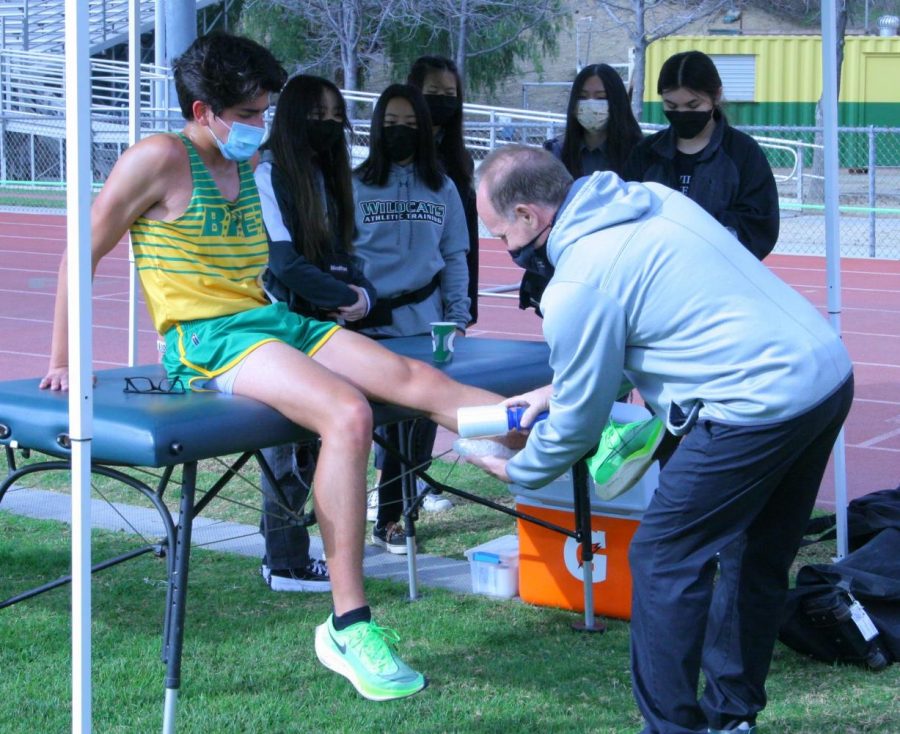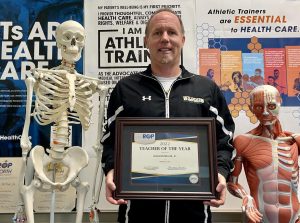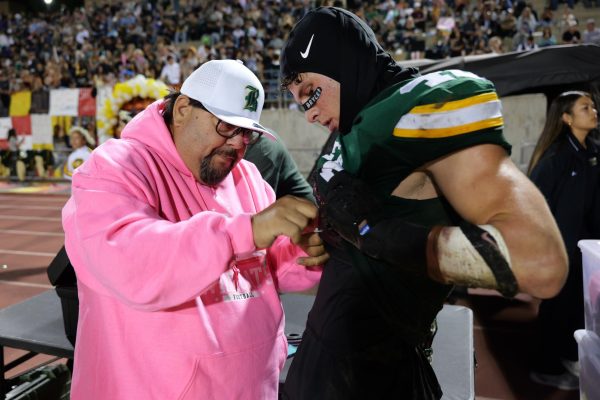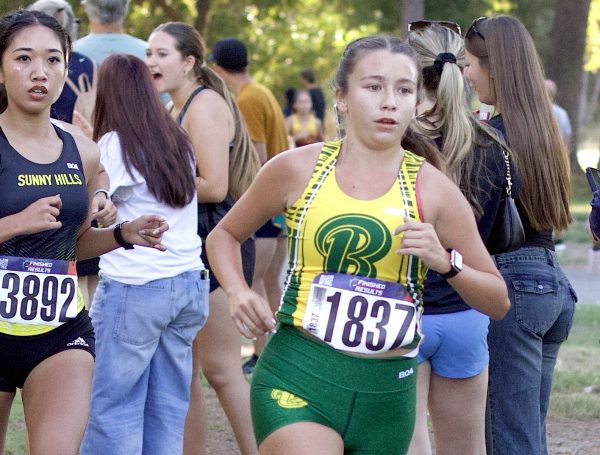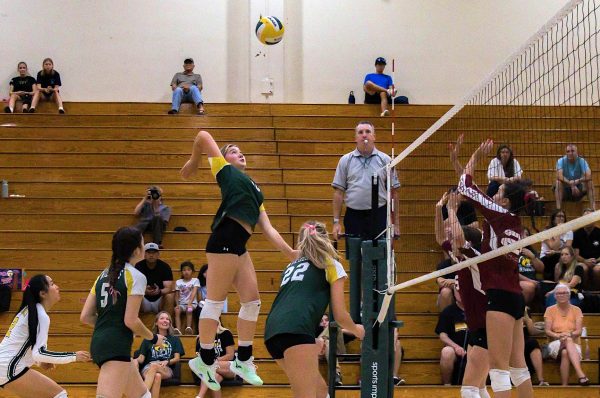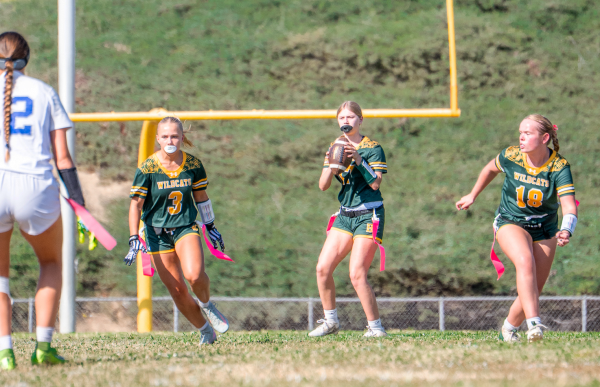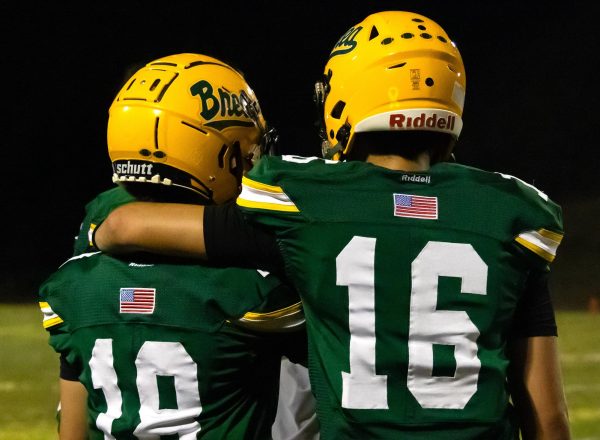Athlete Safety in the COVID-19 Pandemic
In an interview with the Wildcat, BOHS athletic trainer, and North Orange County Teacher of the Year, Ken McCall discusses his role in athlete safety during a pandemic.
Ken McCall, athletic trainer, treats cross country runner Michael Galentine, sophomore, as athletic training student aides look on. As athletic trainer, McCall is responsible for the safety of all athletes at BOHS.
One of the most familiar sights on the BOHS fields is athletic trainer Ken McCall speeding from field to field in a golf cart, hustling to mend injured athletes.
As sports practices have commenced with the easing of restrictions due to declining numbers of COVID-19 infections, McCall is increasingly active in overseeing the health and safety of every athlete on campus. Although competitions are still restricted (cross country is the only sport currently competing), most teams conduct practice daily, McCall and his team of student trainers are there to ensure athletes are tended to.
McCall’s role as an athletic trainer includes preventing, assessing, and treating athletic injuries. But due to COVID-19, his role has been especially crucial in ensuring a safe environment for Wildcat coaches and students.
This is McCall’s 17th year teaching Medical Careers and Sports Medicine and Therapy at BOHS, and his 19th year as athletic trainer at BOHS. On Feb. 10, he was awarded North Orange County ROP Teacher of the Year for his exemplary teaching and meaningful connections with students.
The Wildcat: As the athletic trainer at BOHS, what are your responsibilities?
McCall: In a nutshell, athletic training is about prevention, assessment, treatment, and rehabilitation of athletic injuries. I am responsible for all of the athletes’ healthcare for every sport at the school. Prevention of injuries includes the application of taping techniques, nutrition management, and proper strength training and conditioning programs. Evaluation and diagnosis of injuries or illnesses occur in the clinical setting at the athletic training room or where games and practices are held.
Treatment is based on the diagnosis and can be basic first aid and wound care to CPR and AED use to save a life. Clinical treatments include hydrocollator (heat) pads, electrical stimulation, soft tissue mobilization, and whirlpool treatments. Rehabilitation occurs when athletes have injuries that take them out of practice or competition for days to several months depending on the injury. I work with the athlete to regain range of motion, strength, proprioception (balance), and ultimately functional movements. Education occurs in all of the domains that were discussed previously, and it is imperative to make sure that the athlete understands the importance of compliance.
The Wildcat: How did you adapt to the new regulations for treating athletes?
McCall: COVID-19 put a rapid end to sports practice and competition as we know it. With the off and on of training and conditioning this Fall and winter it has been emotionally challenging for everyone involved. I have had to set up outside since I can’t have athletes in the athletic training room so evaluations and treatments can be challenging. I just have to think outside of the box and get creative.
The Wildcat: How has the pandemic affected how you work with students?
McCall: I have to set up outside every day and bring equipment out in order to be prepared to evaluate and treat an athlete. I also have to utilize PPE and social distance as much as possible.
The Wildcat: Do you go through different protocols when helping athletes in comparison to pre-pandemic conditions?
McCall: I think the biggest thing right now is explaining the importance of wearing their face masks, maintaining safe distances, and proper handwashing guidelines before, during and after seeing me.
The Wildcat: Is there a big gap between the number of students participating in sports contrasting to before COVID-19?
McCall: There has been a decrease in the number of athletes in most sports but there are still a lot of athletes who are doing everything that they can in order to prepare for a chance to compete.
The Wildcat: What has been the greatest challenge of the COVID-19 situation and your responsibilities?
McCall: The greatest challenge so far has been the emotional rollercoaster that we have had to endure but the greatest challenge has yet to come. That will happen if and when sports are allowed to compete again. With so many different boys and girls sports being scheduled to practice and compete during the next 4 to 5 months, I will be spread thin and that could be dangerous since I can’t be three places at once. Additionally, I fear that the lack of regular practices without restrictions and not having normal contact training may result in a significant increase in the likelihood of injuries and illnesses. There will be so much going on that I don’t know how I will be able to supply the demand.
Your donation supports the student journalists at Brea Olinda High School! The contribution will help us purchase equipment, upgrade technology, and cover our annual website hosting costs.
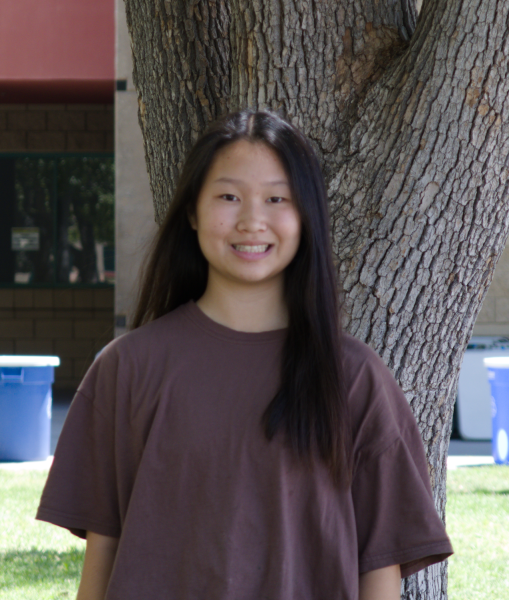
Ellen Kim, senior, has been a member of the newspaper staff since her freshman year and is excited to lead the staff as Editor-in-Chief. Alongside her...
Diana Lee, junior, joined the Wildcat Staff in 2020-2021. She enjoys taking pictures of trips and fun times to look back on for memories. She spends her...


